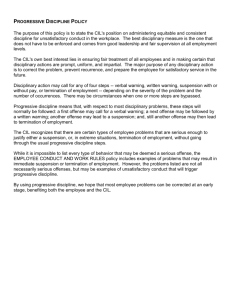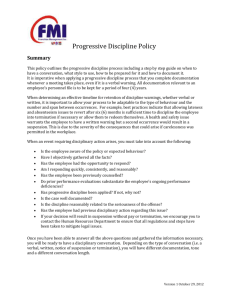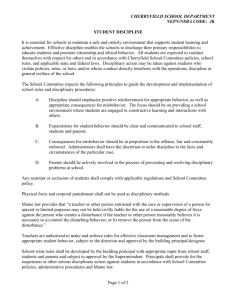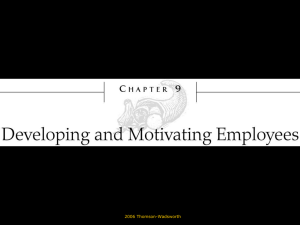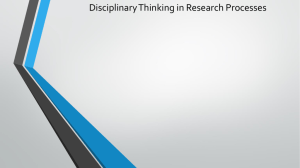Document
advertisement
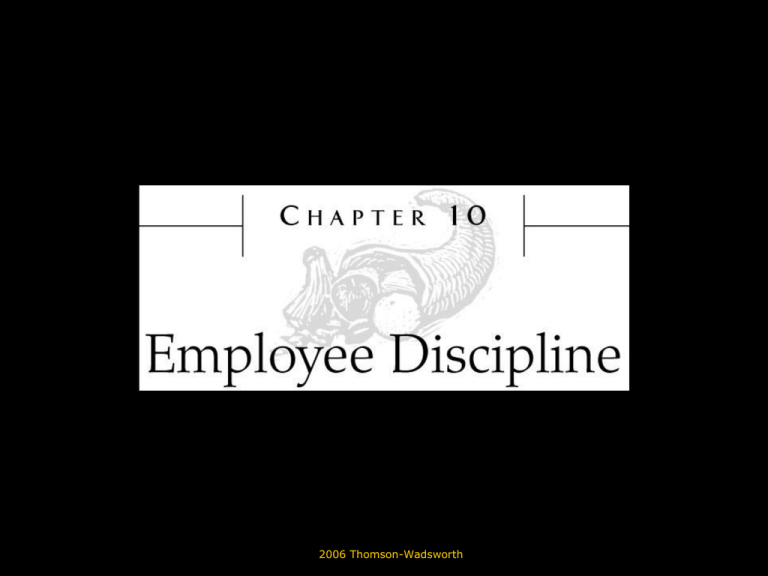
© 2006 Thomson-Wadsworth Learning Objectives • State the purpose of employee discipline. • List common reasons why employees are disciplined. • Identify the reasons for having a written disciplinary policy and procedure. • Describe the components of a disciplinary policy. © 2006 Thomson-Wadsworth Learning Objectives • List the steps included in the disciplinary procedure. • Discuss the importance of timeliness in employee discipline. • Define progressive discipline. • Describe how to conduct each type of disciplinary action. • List situations in which the employee may be terminated without following progressive discipline. © 2006 Thomson-Wadsworth Learning Objectives • Describe the types of documentation necessary during progressive discipline. • Discuss employee assistance programs in conjunction with discipline. • Identify the employee’s rights when there is a conflict with management. • Discuss the grievance process in a nonunionized workplace. • Write a policy and procedure for employee grievances. © 2006 Thomson-Wadsworth The Purpose of Employee Discipline • Employee Discipline – A tool used by managers to improve poor performance and enforce appropriate behavior to ensure a productive and safe workplace. © 2006 Thomson-Wadsworth © 2006 Thomson-Wadsworth The Purpose of Employee Discipline • Eliminate inappropriate behavior • Create a "win-win" situation for manager and subordinates • Not to exercise vengeance or eliminate a problematic employee © 2006 Thomson-Wadsworth The Purpose of Employee Discipline • Neglecting discipline has consequences: – Negative effect on productivity and morale – Difficulty in enforcing long-ignored standards later on • Disciplinary Process - A step-by-step method of dealing with performance problems in employees. © 2006 Thomson-Wadsworth Organizational Policy and Procedure • Policy and Procedure (P&P) – A written standard used within an organization to describe what is to be done and how to do it. – Usually policies and procedures are written for tasks that are done repeatedly and by more than one individual. © 2006 Thomson-Wadsworth Organizational Policy and Procedure • Importance of a written disciplinary policy and procedure – Protects manager and organization – Guarantees rights of employee – Teaches manager how to discipline employees © 2006 Thomson-Wadsworth Organizational Policy and Procedure • Components of policies and procedures – Policy Statement • The component of a P&P that states what is to be done. • Progressive Discipline - A disciplinary process characterized by the use of more drastic penalties for each repeated instance of poor performance. © 2006 Thomson-Wadsworth Organizational Policy and Procedure – Components • Purpose – Statement of Purpose - Part of a P&P that explains rationale for a policy and may include how the policy relates to an organization’s philosophy. • Scope – An optional component of the policy section of a P&P that lists the individuals or groups impacted by the policy. © 2006 Thomson-Wadsworth Organizational Policy and Procedure – Components • Procedure – The step-by-step description of a P&P that states the actions to take, the order in which they should occur, and the timelines to be followed. • Example formats for P&P... © 2006 Thomson-Wadsworth © 2006 Thomson-Wadsworth © 2006 Thomson-Wadsworth Organizational Policy and Procedure – Components • Procedure - usually has a minimum of 4 steps: – Verbal warning – Written warning – Suspension – Termination © 2006 Thomson-Wadsworth Organizational Policy and Procedure – Components • Procedure – Disciplinary Action - The activity performed by a manager when implementing a step in progressive discipline in order to assist an employee to correct a behavioral or performance problem. © 2006 Thomson-Wadsworth The Disciplinary Process • Verbal Warning – The first step in employee discipline, which includes identification of the problem and information sharing between the manager and the employee. – Manager: • • • • • Meets with employee States problem that has been identified Listens to employee's perspective Discusses potential solutions with employee Ends on a positive, hopeful note © 2006 Thomson-Wadsworth The Disciplinary Process • Verbal warning – If employee is unaware of a policy they are violating, they should be coached instead of disciplined – Prior to a verbal warning, manager must become aware of the problem and verify it exists © 2006 Thomson-Wadsworth The Disciplinary Process • Written Warning – The second, more formal, step in employee discipline, which includes stating the problem and noting repetition over time. – Includes: • Meeting similar to verbal warning • Placement of formal document in the employee's file © 2006 Thomson-Wadsworth The Disciplinary Process • Suspension – The third step in the employee disciplinary process, in which the employee is given time off, usually without pay, to demonstrate the seriousness of the problem. – Manager meets with employee as before, and review formal documentation of suspension. © 2006 Thomson-Wadsworth The Disciplinary Process • Termination – The final action in the employee disciplinary process, which leads to the end of employment and that results after repeated failure of the employee to correct the problem. © 2006 Thomson-Wadsworth The Disciplinary Process © 2006 Thomson-Wadsworth The Disciplinary Process • Special circumstances – Certain events may result in termination without progressive discipline – Before immediate termination, manager should consider: • Magnitude of problem behavior • Prior record of employee © 2006 Thomson-Wadsworth © 2006 Thomson-Wadsworth Documentation • Documentation – A written record, in this case of the disciplinary actions taken. • Anecdotal Information – Optional informal notes that are sometimes kept by a manager as a reminder of things that have occurred. © 2006 Thomson-Wadsworth Documentation • Guidelines for anecdotal information: – System should be applied uniformly to all employees – Notes should be factual and non-judgmental – Notes are more useful if dated – Notes may be discarded when no longer needed, or when important information is transferred to official documents © 2006 Thomson-Wadsworth Documentation • Official documentation – Documents dealing with progressive discipline should include: • The employee’s identifying information • The manager’s identifying information • Behavioral or performance problem for which the action is being taken • Description of events and discussions preceding this action • Description of the specific events leading to this action © 2006 Thomson-Wadsworth Documentation • Official documentation – Documents dealing with progressive discipline should include: • Possible consequences if this behavioral or performance problem is not corrected • Duration of the warning • Signature of the manager • Signature of the employee, with a disclaimer regarding agreement – ex: written warning for a diet clerk... © 2006 Thomson-Wadsworth © 2006 Thomson-Wadsworth Employee Assistance Programs • Employee Assistance Programs (EAPs) Plans that provide employees with support in dealing with personal crises (such as substance abuse, stress, or grief) that could negatively impact work performance. © 2006 Thomson-Wadsworth Employee Assistance Programs • Commonly used for employees identified as having or at risk for a substance abuse problem – Drug tests are routinely conducted for workers in certain fields • Participation in an EAP may be required as part of a discipline process • EAPs may be self-operated or contracted from outside providers © 2006 Thomson-Wadsworth Employee Assistance Programs • Benefits: – Restoration of productivity – Avoidance of time/energy needed for progressive discipline – Cost savings (new employee need not be hired/trained) – Employee is assisted in dealing with a potentially devastating personal crisis © 2006 Thomson-Wadsworth Employee Grievances • Employee Grievances – A method for employees to use to resolve conflicts when they feel they have been treated unfairly by management. © 2006 Thomson-Wadsworth Employee Grievances © 2006 Thomson-Wadsworth Employee Grievances • Grievance P&P has the same format as discipline P&P • Typical procedure: – Discuss problem with manager – Discuss problem with manager's superior – Superior may refer problem to grievance committee or CEO • Union employee grievances are handled differently... © 2006 Thomson-Wadsworth Union Employee Grievances • Procedure from contract rather than P&P is followed • Grievances specific to union employees: – Union employee asked to do non-union work – Non-union workers perform union work – Union contract violations © 2006 Thomson-Wadsworth Union Employee Grievances • Union grievances are often resolved through: – Arbitration - A hearing before someone empowered to resolve the dispute. – Mediation - Negotiation between two parties, using a neutral intermediary to assist in settling a dispute. © 2006 Thomson-Wadsworth Conclusion • Employee discipline should be used for the purpose of helping the employee to correct behavioral or performance problems that have a negative impact on the workplace. • A disciplinary policy and procedure should be in place that includes a policy statement, the purpose for the policy, and a step-by-step procedure (with specific timelines) for the process. © 2006 Thomson-Wadsworth Conclusion • The usual steps in a disciplinary procedure include the following disciplinary actions: – Verbal warning – Written warning – Suspension – Termination © 2006 Thomson-Wadsworth Conclusion • Managers must use judgment, empathy, consistency, and fairness when administering employee discipline. • All disciplinary actions should be documented in a factual, nonjudgmental way. © 2006 Thomson-Wadsworth Conclusion • Alternatives to the traditional disciplinary process include the use of employee assistance programs. • Employees can use the grievance procedure to resolve conflicts with management. © 2006 Thomson-Wadsworth

